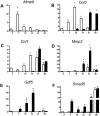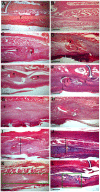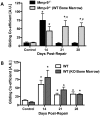Bone marrow-derived matrix metalloproteinase-9 is associated with fibrous adhesion formation after murine flexor tendon injury
- PMID: 22792383
- PMCID: PMC3394706
- DOI: 10.1371/journal.pone.0040602
Bone marrow-derived matrix metalloproteinase-9 is associated with fibrous adhesion formation after murine flexor tendon injury
Abstract
The pathogenesis of adhesions following primary tendon repair is poorly understood, but is thought to involve dysregulation of matrix metalloproteinases (Mmps). We have previously demonstrated that Mmp9 gene expression is increased during the inflammatory phase following murine flexor digitorum (FDL) tendon repair in association with increased adhesions. To further investigate the role of Mmp9, the cellular, molecular, and biomechanical features of healing were examined in WT and Mmp9(-/-) mice using the FDL tendon repair model. Adhesions persisted in WT, but were reduced in Mmp9(-/-) mice by 21 days without any decrease in strength. Deletion of Mmp9 resulted in accelerated expression of neo-tendon associated genes, Gdf5 and Smad8, and delayed expression of collagen I and collagen III. Furthermore, WT bone marrow cells (GFP(+)) migrated specifically to the tendon repair site. Transplanting myeloablated Mmp9(-/-) mice with WT marrow cells resulted in greater adhesions than observed in Mmp9(-/-) mice and similar to those seen in WT mice. These studies show that Mmp9 is primarily derived from bone marrow cells that migrate to the repair site, and mediates adhesion formation in injured tendons. Mmp9 is a potential target to limit adhesion formation in tendon healing.
Conflict of interest statement
Figures






Similar articles
-
Low-Dose and Short-Duration Matrix Metalloproteinase 9 Inhibition Does Not Affect Adhesion Formation during Murine Flexor Tendon Healing.Plast Reconstr Surg. 2016 Mar;137(3):545e-553e. doi: 10.1097/01.prs.0000475823.01907.53. Plast Reconstr Surg. 2016. PMID: 26910699 Free PMC article.
-
Remodeling of murine intrasynovial tendon adhesions following injury: MMP and neotendon gene expression.J Orthop Res. 2009 Jun;27(6):833-40. doi: 10.1002/jor.20769. J Orthop Res. 2009. PMID: 19051246 Free PMC article.
-
Impact of Smad3 loss of function on scarring and adhesion formation during tendon healing.J Orthop Res. 2011 May;29(5):684-93. doi: 10.1002/jor.21235. Epub 2010 Sep 14. J Orthop Res. 2011. PMID: 20842701 Free PMC article.
-
Flexor tendon biology.Hand Clin. 2005 May;21(2):159-66. doi: 10.1016/j.hcl.2004.11.009. Hand Clin. 2005. PMID: 15882594 Review.
-
Biologic and mechanical aspects of tendon fibrosis after injury and repair.Connect Tissue Res. 2019 Jan;60(1):10-20. doi: 10.1080/03008207.2018.1512979. Epub 2018 Sep 7. Connect Tissue Res. 2019. PMID: 30126313 Review.
Cited by
-
Parathyroid hormone 1-34 enhances extracellular matrix deposition and organization during flexor tendon repair.J Orthop Res. 2015 Jan;33(1):17-24. doi: 10.1002/jor.22735. Epub 2014 Sep 29. J Orthop Res. 2015. PMID: 25266795 Free PMC article.
-
Obesity/Type II diabetes alters macrophage polarization resulting in a fibrotic tendon healing response.PLoS One. 2017 Jul 7;12(7):e0181127. doi: 10.1371/journal.pone.0181127. eCollection 2017. PLoS One. 2017. PMID: 28686669 Free PMC article.
-
Development of antisense oligonucleotide (ASO) technology against Tgf-β signaling to prevent scarring during flexor tendon repair.J Orthop Res. 2015 Jun;33(6):859-66. doi: 10.1002/jor.22890. J Orthop Res. 2015. PMID: 25761254 Free PMC article.
-
Tendon regeneration and scar formation: The concept of scarless healing.J Orthop Res. 2015 Jun;33(6):823-31. doi: 10.1002/jor.22853. Epub 2015 Apr 27. J Orthop Res. 2015. PMID: 25676657 Free PMC article. Review.
-
The cellular basis of fibrotic tendon healing: challenges and opportunities.Transl Res. 2019 Jul;209:156-168. doi: 10.1016/j.trsl.2019.02.002. Epub 2019 Feb 8. Transl Res. 2019. PMID: 30776336 Free PMC article. Review.
References
-
- Beredjiklian PK. Biologic aspects of flexor tendon laceration and repair. J Bone Joint Surg Am. 2003;85-A:539–550. - PubMed
-
- Lin T. Biomechanics of tendon inury and repair. Journal of Biomechanics. 2004;37:865–877. - PubMed
-
- Gelberman RH, Botte MJ, Spiegelman JJ, Akeson WH. The excursion and deformation of repaired flexor tendons treated with protected early motion. J Hand Surg [Am] 1986;11:106–110. - PubMed
-
- Gelberman RH, Woo SL, Lothringer K, Akeson WH, Amiel D. Effects of early intermittent passive mobilization on healing canine flexor tendons. J Hand Surg [Am] 1982;7:170–175. - PubMed
-
- Sharma P, Maffulli N. Basic biology of tendon injury and healing. Surgeon. 2005;3:309–316. - PubMed
Publication types
MeSH terms
Substances
Grants and funding
LinkOut - more resources
Full Text Sources
Other Literature Sources
Molecular Biology Databases
Miscellaneous

